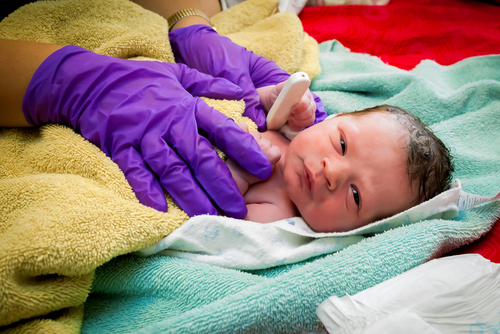‘Collodion’ Skin Disorder in Newborn Early Sign of Severe Perinatal Type 2 Gaucher, Case Study Suggests
Written by |

Infants who are born encased in a tight and shiny membrane made of skin cells that resembles plastic wrap, and commonly called “collodion babies,” may have severe perinatal (fetal) Gaucher disease, a case report suggests.
While the relationship between the two is fully established, this report highlights the importance of considering a Gaucher diagnosis for prompt palliative care.
The study, “Gaucher Disease – A Rare Cause of Collodion,” was published in The Indian Journal of Pediatrics.
It details a baby boy who the second infant of a twin pregnancy in which each fetus has its own amniotic sac and placenta. During prenatal evaluations, he was noted to have fluid build-up in his abdomen, scrotum, and around the heart.
As a newborn he had features of collodion baby — with tight, shiny skin — along with purple skin spots, everted eyelids (exposed conjunctiva), abdominal distension, an enlarged spleen and liver, and a swollen scrotum.
Initial clinical analysis showed persistently low platelet counts and high levels of bilirubin (a component of red blood cells) on his first day of life. All tests for viral infections came out negative.
An abdominal ultrasound confirmed a mild-to-moderate enlargement of the spleen and liver, and further exams showed highly elevated ferritin (the protein carrying iron in the blood) and mildly increased ammonia.
Investigators suspected Gaucher disease, and examined the amount of β-glucocerebrosidase — the enzyme whose gene is mutated in Gaucher patients — in dried blood spots as well as chitotriosidase, which is normally used to monitor Gaucher disease activity.
The baby had low β-glucocerebrosidase and elevated chitotriosidase levels, which confirmed the diagnosis of a lethal form of type 2 Gaucher disease, present before birth.
“In this case, the combination of hepatosplenomegaly [enlarged liver and spleen], the timeline of presentation, thrombocytopenia, elevated ferritin, and collodion membrane suggested perinatal Gaucher disease,” they wrote.
Genetic analysis confirmed that the patient had two copies (one inherited from the mother and one from the father) of a disease-causing mutation (p.Arg324His) in the GBA gene, which is known to be the cause of Gaucher disease.
The boy was given supportive palliative care with high humidity, topical skin moisturizers, nutrition through a feeding tube, and antibiotics. Given the severity of the disease, he died from multi-organ failure within a month of birth (age 22 days).
Standard treatment for Gaucher disease is enzyme replacement therapy and substrate reduction therapy. These approaches can be beneficial for other forms of the disease, “but not for the lethal perinatal Gaucher disease,” the researchers wrote.
“This case illustrates the importance of considering lethal form of Gaucher’s disease in a Collodion baby and providing palliative care in these cases,” they concluded.



